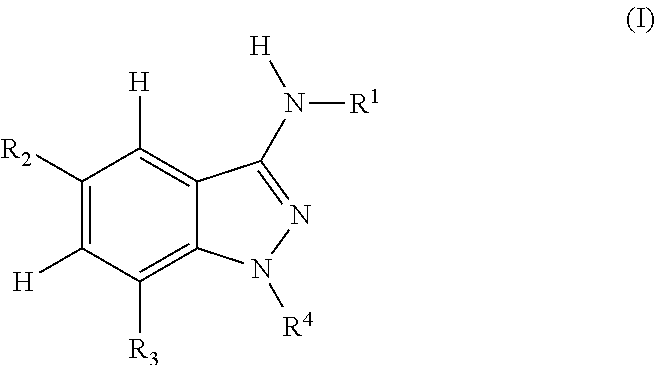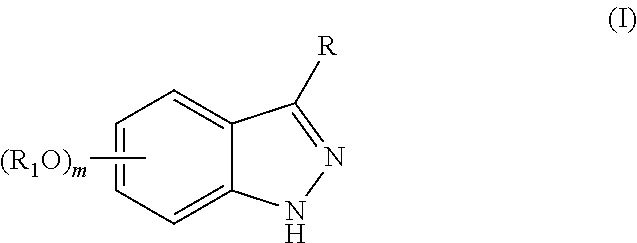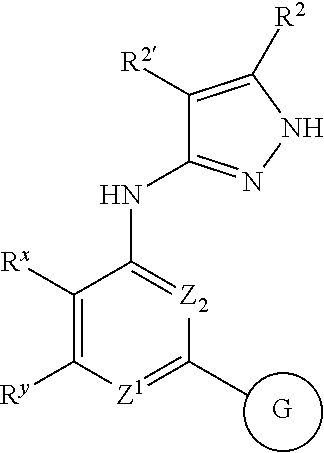Indazole compounds for activating glucokinase
a technology of glucokinase and indazole, which is applied in the field of indazole compounds, can solve the problems of impaired glucose tolerance and diabetes, insulin secretion failure, and lower liver glucose metabolism, and achieves the effects of reducing side effects, reducing toxicity, and superior gk activating action
- Summary
- Abstract
- Description
- Claims
- Application Information
AI Technical Summary
Benefits of technology
Problems solved by technology
Method used
Image
Examples
reference example 1
2-fluoro-5-(2-thienyl)benzonitrile
[0854]
[0855]To a N,N-dimethylformamide solution (20 mL) of 5-bromo-2-fluorobenzonitrile (1.50 g) were added 2-(tributylstannyl)thiophene (4.20 g) and tetrakis(triphenylphosphine)palladium(0) (433 mg) under nitrogen stream, and the mixture was stirred at 80° C. overnight. The mixture was allowed to cool, and the reaction mixture was diluted with ethyl acetate, and washed with 1N hydrochloric acid, water and saturated brine. The mixture was dried over anhydrous magnesium sulfate, and concentrated under reduced pressure. The residue was subjected to NH-silica gel chromatography (eluate: ethyl acetate), and the obtained crude crystals were purified by recrystallization (hexane) to give the title compound (1.35 g, 89%) as colorless crystals. 1H NMR (300 MHz, CDCl3) δ ppm 7.11 (dd, J=5.09, 3.77 Hz, 1H) 7.19-7.32 (m, 2H) 7.36 (dd, J=5.09, 0.94 Hz, 1H) 7.73-7.92 (m, 2 H).
reference example 2
5-(2-thienyl)-1H-indazole-3-amine
[0856]
[0857]To an ethanol solution (20 mL) of 2-fluoro-5-(2-thienyl)benzonitrile (700 mg) was added hydrazine monohydrate (0.50 mL) and heated under reflux overnight. The solvent was evaporated under reduced pressure, and diluted with ethyl acetate. The organic layer was washed with water and saturated brine, dried over anhydrous magnesium sulfate, and concentrated under reduced pressure. The obtained crude crystals were purified by recrystallization (hexane-ethyl acetate) to give the title compound (638 mg, yield 86%) as colorless crystals.
[0858]MS: 216 (MH+).
reference example 3
N-[5-(2-thienyl)-1H-indazol-3-yl]thiourea
[0859]
[0860]To a solution of 5-(2-thienyl)-1H-indazole-3-amine (400 mg) in tetrahydrofuran (10 mL) was added 1,1′-carbonothioyldipyridine-2(1H)-one (475 mg) at 0° C., stirred for 30 min, and concentrated aqueous ammonia (5 mL) was added. The reaction mixture was stirred for 1 hr at room temperature, water was added, and extracted with ethyl acetate. The ethyl acetate layer was washed with saturated brine, dried over anhydrous magnesium sulfate, and concentrated under reduced pressure. Purification by recrystallization (hexane-ethyl acetate) gave the title compound (383 mg, 75%) was obtained as colorless crystals. MS: 275 (MH+).
PUM
| Property | Measurement | Unit |
|---|---|---|
| concentration | aaaaa | aaaaa |
| concentration | aaaaa | aaaaa |
| concentration | aaaaa | aaaaa |
Abstract
Description
Claims
Application Information
 Login to view more
Login to view more - R&D Engineer
- R&D Manager
- IP Professional
- Industry Leading Data Capabilities
- Powerful AI technology
- Patent DNA Extraction
Browse by: Latest US Patents, China's latest patents, Technical Efficacy Thesaurus, Application Domain, Technology Topic.
© 2024 PatSnap. All rights reserved.Legal|Privacy policy|Modern Slavery Act Transparency Statement|Sitemap



